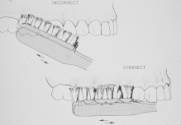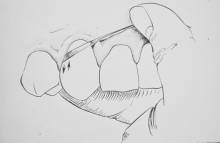Preventing Gum Disease

Adults past the age of 35 lose more teeth to gum diseases than from cavities. Three out of four adults are affected at some time in their life. The best way to prevent cavities and periodontal diseases is by good tooth brushing and flossing techniques, performed daily, and regular professional examinations, wisdom teeth removal and cleanings. Unfortunately, even with the most diligent home dental care, people still can develop some form of periodontal disease. Once this disease starts, professional intervention is necessary to prevent its progress.
Other important factors affecting the health of your gums include:
- Tobacco Usage
- Diabetes
- Stress
- Clenching and grinding teeth
- Medication
- Poor nutrition
Periodontal Disease and Tobacco
You are probably familiar with the links between tobacco use and lung disease, cancer and heart disease.
Current studies have now linked periodontal disease with tobacco usage. These cases may be even more severe than those of non-users of tobacco. There is a greater incidence of calculus formation on teeth, deeper pockets between gums and teeth as well as greater loss of the bone and fibers that hold teeth in your mouth. In addition, your chance of developing oral cancer increases with the use of smokeless tobacco.
Chemicals in tobacco such as nicotine and tar, slow down healing and the predictability of success following periodontal treatment. Problems caused by tobacco include:
- Lung Disease
- Heart Disease
- Cancer
- Mouth Sores
- Gum Recession
- Loss of Bone and Teeth
- Bad Breath
- Tooth Staining
- Less Success with periodontal treatment and with dental implants
Quitting smoking will reduce the chance of developing the above problems.
For helpful ideas on how to quit using tobacco, please got to www.philipmorris.com. Diabetes and Oral Health
Individuals suffering from diabetes, especially uncontrolled diabetics, have a higher risk of developing bacterial infections of the mouth. These infections may impair your ability to process insulin, resulting in greater difficulty with controlling your diabetes. Periodontal diseases will be more severe than those of a non-diabetic and treatment more difficult. However, well-controlled diabetics have a lower incidence of periodontal disease.
Steps to prevent periodontal disease include daily brushing and flossing to remove plaque from your teeth and gums, regular dental visits for professional cleaning and regular periodontal evaluation. Your health professional must also be told of your history and the current status of your condition. And finally, you can help resist periodontal infection by maintaining control of your blood sugar levels.
Consult with one of our periodontists
Periodontal Disease, Heart Disease and Stroke
The bacteria found in periodontal pockets are the same bacteria found in the plaques of blocked blood vessels. These blocked blood vessels are precursors to heart attack and stroke. While there can be no positive cause and effect, there is at least an association between patients with severe periodontal disease and patients who also have heart attacks and stroke. The logical conclusion would be to keep periodontal disease under control. Not only will the patients keep their teeth longer, but this may prevent more serious problems such as heart attack and stroke as a result of having healthy gums.
Women and Periodontal Health
Throughout a woman’s life, hormonal changes affect tissue throughout the body. Fluctuations in levels occur during puberty, pregnancy and menopause. At these times, the chance of periodontal disease may increase, requiring special care of your oral health. Our Women and Periodontal Health section reviews these issues in depth. Also, Dr. Kolinski’s newsletter entitled Nutritional Guidelines for Patients with Periodontal Disease addresses additional women nutritional needs in relation to dental health. Puberty
During puberty, there is increased production of hormones. These higher levels increase gum sensitivity and lead to greater irritations from plaque and food particles. The gums can become swollen, turn red and feel tender. Menstruation
Similar symptoms occasionally appear several days before menstruation. There can be bleeding of the gums, bright red swelling between the teeth and gum, or sores on the inside of the cheek. The symptoms clear up once the period has started. As the amount of sex hormones decrease, so do these problems. Pregnancy
Your gums and teeth are also affected during pregnancy. Between the second and eighth month, your gums may also swell, bleed and become red or tender. Large lumps may appear as a reaction to local irritants. However, these growths are generally painless and not cancerous. They may require professional removal, but usually disappear after pregnancy.
Periodontal health should be part of your prenatal care. Any infections during pregnancy, including periodontal infections, can place a baby’s health at risk. There is an association between pregnant patients with periodontal disease and the incidence of low birth weight babies. To date, it is not clear if these findings are coincident problems or a cause and effect relationship. The safest approach is to keep the gums healthy during pregnancy to reduce the incidence of low birth weight babies.
The best way to prevent periodontal infections is to begin with healthy gums and continue to maintain your oral health with proper home care and careful periodontal monitoring. Oral Contraceptives
Swelling, bleeding and tenderness of the gums may also occur when you are taking oral contraceptives, which are synthetic hormones.
You must mention any prescriptions you are taking, including oral contraceptives, prior to medical or dental treatment. This will help eliminate risk of drug interactions, such as antibiotics with oral contraceptives – where the effectiveness of the contraceptive can be lessened. Menopause
Visit our gallery to see real patient results
Changes in the look and feel of your mouth may occur if you are menopausal or post-menopausal. They include feeling pain and burning in your gum tissue and salty, peppery or sour tastes.
Careful oral hygiene at home and professional cleaning may relieve these symptoms. There are also saliva substitutes to treat the effects of ‘dry mouth,’ Oral
How to Brush
 |
 |
To brush the outside surfaces of your teeth, position the brush at a 45-degree angle where your gums and teeth meet. Gently move the brush in a circular motion several times using small, gentle strokes. Use light pressure while putting the bristles between the teeth, but not so much pressure that you feel any discomfort.
When you are done cleaning the outside surfaces of all your teeth, follow the same directions while cleaning the inside of the back teeth.
To clean the inside surfaces of the upper and lower front teeth, hold the brush vertically. Make several gentle back-and-forth strokes over each tooth. Don’t forget to gently brush the surrounding gum tissue.
Next you will clean the biting surfaces of your teeth. To do this use short, gentle strokes. Change the position of the brush as often as necessary to reach and clean all surfaces. Try to watch yourself in the mirror to make sure you clean each surface. After you are done, rinse vigorously to remove any plaque you might have loosened while brushing.
If you have any pain while brushing or have any questions about how to brush properly, please be sure to call the office.
How to Floss
Periodontal disease usually appears between the teeth where your toothbrush cannot reach. Flossing is a very effective way to remove plaque from those surfaces. However, it is important to develop the proper technique. The following instructions will help you, but remember it takes time and practice.
Start with a piece of floss about 18″ long. Lightly wrap most of the floss around the middle finger of one hand. Wrap the rest of the floss around the middle finger of the other hand.
To clean the upper teeth, hold the floss tightly between the thumb and forefinger of each hand. Gently insert the floss tightly between the teeth using a back-and-forth motion. Do not force the floss or try to snap it in to place. Bring the floss to the gum line then curve it into a C-shape against one tooth. Slide it into the space between the gum and the tooth until you feel light resistance. Move the floss up and down on the side of one tooth. Remember there are two tooth surfaces that need to be cleaned in each space. Continue to floss each side of all the upper teeth. Be careful not to cut the gum tissue between the teeth. As the floss becomes soiled, turn from one finger to the other to get a fresh section.
 |
 |
To clean between the bottom teeth, guide the floss using the forefinger of both hands. Do not forget the back side of the last tooth on both sides, upper and lower.
When you are done, rinse vigorously with water to remove plaque and food particles. Do not be alarmed if during the first week of flossing your gums bleed or are a little sore. If your gums hurt while flossing you could be doing it too hard or pinching the gum. As you floss daily and remove the plaque your gums will heal and the bleeding should stop. Caring for Sensitive Teeth
Sometimes after dental treatment, teeth are sensitive to hot and cold. This should not last long, but only if the mouth is kept clean. If the mouth is not kept clean the sensitivity will remain and could become more severe. If your teeth are especially sensitive consult with our doctors. They may recommend a medicated toothpaste or mouth rinse made especially for sensitive teeth. Choosing Oral Hygiene Products
There are so many products on the market it can become confusing and choosing between all the products can be difficult. Here are some suggestions for choosing dental care products that will work for most patients.
Automatic and “high-tech” electronic toothbrushes are safe and effective for the majority of the patients. We see excellent results with electric toothbrushes manufactured by Oral-B and Braun.
Oral irrigators (water spraying devices) will rinse your mouth thoroughly, but will not remove plaque. You need to brush and floss in conjunction with the irrigator.
Some toothbrushes have a rubber tip on the handle; this is used to massage the gums after brushing. There are also tiny brushes, called interproximal toothbrushes, which clean between your teeth. If these are used improperly you could injure the gums, so discuss proper use with your doctor.
Fluoride toothpastes and mouth rinses if used in conjunction with brushing and flossing can reduce tooth decay as much as 40%. Remember, these rinses are not recommended for children under six years of age. Tartar control toothpastes will reduce tartar above the gum line, but gum disease starts below the gum line so these products have not been proven to reduce the early stage of gum disease.
Our doctors are the best resource to help you select the right products that are best for you.
Professional Cleaning
Daily brushing and flossing will keep dental calculus to a minimum, but a professional cleaning will remove calculus in places your toothbrush and floss have missed. Visiting a periodontist is an important part of your program to prevent gum disease. Keep your teeth for your lifetime. Utilizing the Available Tools Bite Adjustment Night Guard
Helpful for patients who grind their teeth. These appliances can be obtained from your dentist. Smoking Cessation Programs
American Cancer Society
